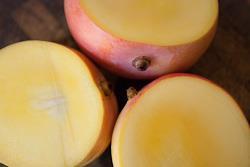
Light and late sums up the production forecast for two of Australia’s major mango production bases in the Northern Territory this season.
After solid 2012 harvests, hopes were high for an above average crop out of Darwin and Katherine this year to help leverage growing interest from a number of Asian markets, most notably China.
However, with temperatures failing to drop low enough to initiate flowering – a run of 10 days under 12oC is generally required - there are suggestions the total volume of the Northern Territory crop could fall by up to 40 per cent.
“We never had any consistency with the growing conditions, it just didn’t get cold enough for long enough,” says Brett Jackson, produce marketing manager of grower-packer-exporter Seven Fields, which has a production base in Katherine.
“The lack of cold nights meant there was late flowering which means we probably won’t start picking until early November. We normally start about the middle of October.”
The outlook for the Kensington Pride variety looks particularly grim, with production around Darwin likely to be 40 per cent smaller than last year, according to Geoff Hagarty, general manger of AFPC Exports.
Hagarty says the forecast is slightly better for Katherine’s Kensington Pride crop, but it would still be a challenging year for producers of the popular variety and the Northern Territory industry as a whole.
“Katherine production of Kensington Pride mangoes is weaker than previous years, but not as drastically down as Darwin,” Hagarty explains.“Other varieties in the Katherine and Darwin production areas are not as far down but obviously this will have an impact on Darwin and later Katherine growing districts.”
Chris Deveney of grower-marketer-exporter Favco says the same problem is also being experienced in Kununurra, in northeastern Western Australia.
“This season will be lucky to do 120,000 trays (20,000 Kensington Pride and 100,000 R2E2) from Kununurra,” Deveney explains. “In a normal year it should produce around 500,000 cartons. Our farms in Mundubbera, Queensland, are the opposite, where we have a strong flowering and should produce between 100,000 and 120,000 cartons of Kensington Pride post Christmas.”
Gavin Scurr, chairman of the Australian Mango Industry Association, says current indications suggest the industry will produce around 7.5m cartons, and that while Northern Territory production could be down by 25 per cent, Queensland is on course for similar volume to last year.
Rising to the export challenge
Indeed, Australian exporters remain confident about holding ground in the Asian markets they have been bidding to develop.
Demand for the R2E2 variety has been rising steadily in China over recent years and Jackson is confident consumer interest will remain high.
“China will pay good money for good-quality fruit and that is what Australian-grown R2E2 is,” Jackson tells Asiafruit. “While volume will be down the quality is still there and I don’t think we will lose ground in the market.”
While their mangoes are capturing the attention of Asian consumers, Australian growers and exporters still face some major challenges accessing Asian markets.
The Australian industry has been campaigning for revised import protocols in a number of markets for close to a decade, with reduced tariff rates and the relaxation of biosecurity regulations major sticking points.
“The current protocols into China, Japan and South Korea are not practical due to the requirement for vapour heat treatment (VHT),” Hagarty says. “There is lack of access to VHT facilities in Australia and VHT often results in a loss of fruit.”
Deveney says new avenues are being explored to secure a more workable protocol in China.
“We are encouraging our Chinese customers to go to the Chinese officials and ask for change,” Deveney explains. “Instead of the same exporters going back time after time we are trying to create demand on the other side of the fence. The protocol in place at the moment is too harsh on both fruit and price. The Australian industry needs change to become a major player in China.”
New varieties to pique Asian palate
Along with market access, key players within the Australian industry are also investing in varietal development to appeal further to a wide-held consumer preference in Asia for high-coloured, sweet tasting fruit.
“Our mango crop profile is constantly evolving with development of new varieties,” Hagarty says.“We support our supply base in developing higher coloured strains in existing mainstays like Kensington Pride and Keitt varieties.”
Seven Fields also has a new offering, after the launch of its proprietary variety, Lady Jane. With a bright red blush and sweet yellow flesh, Jackson says Lady Jane is likely to appeal to consumers across Asia when it reaches commercial volumes in 2016.'
Australian exporters are also working to position their fruit in Asian markets with a more cosmopolitan demographic. “We are doing two or three containers to both Hong Kong and Singapore per week,” Deveney says. “There are large expat communities there, so demand for high-quality fruit is fairly high and we see room to grow our share in both of these markets.”



